Abstract
Virulent Aeromonas hydrophila (vAh) is one of the most important bacterial pathogens that causes persistent outbreaks of motile Aeromonas septicemia in warm-water fishes. The survivability of this pathogen in aquatic environments is of great concern. The aim of this study was to determine the capability of the vAh strain ML10-51K to degrade and utilize chitin. Genome-wide analysis revealed that ML10-51K encodes a suite of proteins for chitin metabolism. Assays in vitro showed that four chitinases, one chitobiase and one chitin-binding protein were secreted extracellularly and participated in chitin degradation. ML10-51K was shown to be able to use not only N-acetylglucosamine and colloidal chitin but also chitin flakes as sole carbon sources for growth. This study indicates that ML10-51K is a highly chitinolytic bacterium and suggests that the capability of effective chitin utilization could enable the bacterium to attain high densities when abundant chitin is available in aquatic niches.


Similar content being viewed by others
References
Bai Y, Eijsink VGH, Kielak AM, van Veen JA, de Boer W (2016) Genomic comparison of chitinolytic enzyme systems from terrestrial and aquatic bacteria. Environ Microbiol 18:38–49
Bebak J, Wagnerb B, Burnesc B, Hanson T (2015) Farm size, seining practices, and salt use: risk factors for Aeromonas hydrophila outbreaks in farm-raised catfish, Alabama, USA. Prev Vet Med 118:161–168
Beier S, Bertilsson S (2011) Uncoupling of chitinase activity and uptake of hydrolysis products in freshwater bacterioplankton. Limnol Oceanogr 56:1179–1188
Beier S, Bertilsson S (2013) Bacterial chitin degradation—mechanisms and ecophysiological strategies. Front Microbiol 4:149. doi:10.3389/Fmicb.2013.00149
Bond DR, Tsai BM, Russell JB (1999) Physiological characterization of Streptococcus bovis mutants that can resist 2-deoxyglucose-induced lysis. Microbiology 145:2977–2985
Chaudhuri S, Gabter BN, Ye RD, Cianciotto NP, Freitag NE (2013) The Listeria monocytogenes ChiA chitinase enhances virulence through suppression of host innate immunity. mBio 4(2):e00617-12. Doi:10.1128/mBio.00617-12
Chen JP, Nagayama F, Chang MC (1991) Cloning and expression of an Aeromonas hydrophila chitinase gene in Escherichia coli. Appl Environ Microbiol 57:2426–2428
Frederiksen RF, Paspaliari DK, Larsen T, Storgaard BG, Larsen MH, Ingmer H, Palcic MM, Leisner JJ (2013) Bacterial chitinases and chitin-binding proteins as virulence factors. Microbiology 159:833–847
Griffin MJ, Goodwin AE, Merry GE, Liles MR, Williams MA, Ware C, Waldbieser GC (2013) Rapid quantitative detection of Aeromonas hydrophila strains associated with disease outbreaks in catfish aquaculture. J Vet Diagn Invest 25:473–481
Hemstreet W (2010) An update on Aeromonas hydrophila from a fish health specialist for summer 2010. Catfish J 24:4
Hossain MJ, Sun DW, Mcgarey DJ, Wrenn S, Alexander LM, Martino ME, Xing Y, Terhune JS, Liles MR (2014) An Asian origin of virulent Aeromonas hydrophila responsible for disease epidemics in United States-Farmed Catfish. MBio 5(3):e00848-14. doi:10.1128/mBio.00848-14
Jeney Z, Jeney G (1995) Recent achievements in studies on diseases of common carp (Cyprinus carpio L.). Aquaculture 129:397–420
Lan X, Zhang X, Hu J, Shimosaka M (2006) Cloning, expression, and characterization of a chitinase from the chitinolytic bacterium Aeromonas hydrophila strain SUWA-9. Biosci Biotechnol Biochem 70:2437–2442
Mondal M, Nag D, Koley H, Saha DR, Chatterjee NS (2014) The Vibrio cholera extracellular chitinase ChiA2 is important for survival and pathogenesis in the host intestine. PLoS ONE 9(9):e103119. doi:10.1371/journal.pone.0103119
Nielsen ME, Hoi L, Schmidt AS, Qian D, Shimada T, Shen JY, Larsen JL (2001) Is Aeromonas hydrophila the dominant motile Aeromonas species that causes disease outbreaks in aquaculture production in the Zhejiang province of China? Dis Aquat Org 46:23–29
Pang M, Jiang J, Xie X, Wu Y, Dong Y, Kwok AH, Zhang W, Yao H, Lu C, Leung FC, Liu Y (2015) Novel insights into the pathogenicity of epidemic Aeromonas hydrophila ST251 clones from comparative genomics. Sci Rep 5:9833. doi:10.1038/srep09833
Pemberton JM, Kidd SP, Schmidt R (1997) Secreted enzymes of Aeromonas. FEMS Microbiol Lett 152:1–10
Plumb JA, Hanson LA (2011) Health maintenance and principal microbial diseases of cultured fishes, 3rd edn. Wiley-Blackwell, Ames, IA, p 492
Rasmussen-Ivey CR, Hossain MJ, Odom SE, Terhune JS, Hemstreet WG, Shoemaker CA, Zhang D, Xu D-H, Griffin MJ, Liu Y-J, Figueras MJ, Santos SR, Newton JC, Liles MR (2016) Classification of a hypervirulent Aeromonas hydrophila pathotype responsible for epidemic outbreaks in warm-water fishes. Front Microbiol 7:1615. doi:10.3389/fmicb.2016.01615
Svitil AL, Chadhain SMN, Moore JA, Kirchman DL (1997) Chitin degradation proteins produced by the marine bacterium Vibrio harveyi growing on different forms of chitin. Appl Environ Microbiol 63:408–413
Tran HT, Barnich N, Mizoguchi E (2011) Potential role of chitinases and chitin-binding proteins in host-microbial interactions during the development of intestinal inflammation. Histol Histopathol 26:1453–1464
Vaaje-Kolstad G, Horn SJ, Sørlie M, Eijsink GH (2013) The chitinolytic machinery of Serratia marcescenes —a model system for enzymatic degradation of recalcitrant polysaccharides. FEBS J 280:3028–3049
Zhang D, Pridgeon JW, Klesius PH (2014) Vaccination of channel catfish with extracellular products of Aeromonas hydrophila provides protection against infection by the pathogen. Fish Shellfish Immunol 36:270–275
Zhang D, Bland JB, Xu D, Chung S (2015) Degradation of chitin and chitosan by recombinant chitinase derived from a virulent Aeromonas hydrophila isolated from diseased channel catfish. AiM 5:611–619. doi:10.4236/aim.2015.59064
Acknowledgement
Dr. Junqiang Qiu was a visiting scientist, sponsored by special funds for the Development of Science & Technology of Shanghai Ocean University, to USDA-ARS Aquatic Animal Health Research Unit. This research was supported by USDA-ARS CRIS Project #6010-32000-026-00D. All authors certify that there is no conflict of interest with any financial/research/academic organization.
Author information
Authors and Affiliations
Corresponding author
Additional information
Communicated by Erko Stackebrandt.
Electronic supplementary material
Below is the link to the electronic supplementary material.
Rights and permissions
About this article
Cite this article
Zhang, D., Xu, DH., Qiu, J. et al. Chitin degradation and utilization by virulent Aeromonas hydrophila strain ML10-51K. Arch Microbiol 199, 573–579 (2017). https://doi.org/10.1007/s00203-016-1326-1
Received:
Revised:
Accepted:
Published:
Issue Date:
DOI: https://doi.org/10.1007/s00203-016-1326-1




